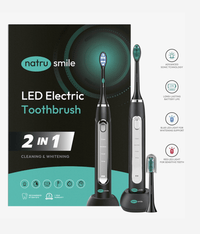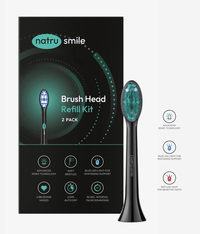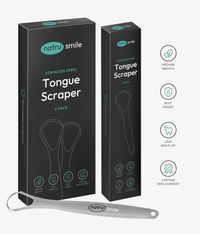
All products are certified by dental expert Dr. Greg Grillo
Having braces can be a major adjustment for many people. Keeping your teeth clean while wearing them can be a challenge, but it’s essential to maintain oral hygiene and prevent tooth decay and gum disease.
With the right techniques, tools, and considerations, cleaning teeth with braces doesn’t have to be a hassle. Here are 6 tips to help you keep your teeth clean with braces.
6 Proven Ways To Easily Clean Teeth With Braces
When it comes to dental cleaning with braces, there are a variety of both science-backed and dentist-approved methods to keep your smile healthy and pearly white.
Clean With Mouthwash At Night
One of the best ways to clean your teeth with braces is to use a mouthwash nightly.
Hailed as one of the most effective at-home ways to maintain your oral hygiene and keep your teeth cleaning cost low, mouthwash (also commonly known as “mouth rinse”) is a liquid solution that can be bought either over-the-counter or directly from your dentist. Antimicrobials in mouthwash formulations include chlorhexidine, chlorine dioxide, and essential oils (like eucalyptol or menthol); other agents used in mouthwash target odor, like ketone, terpene, and ionone.
Mouthwash offers the advantage of reaching areas of the mouth not easily accessed by a toothbrush or even floss, meaning that it can effectively dislodge debris from hard-to-reach places. For best results, it’s recommended to use mouthwash twice a day directly after completing your brushing routine. It is frequently used to combat bad breath, plaque, and gingivitis.
Use A Floss Threader Or Waterpik
To relieve pain after teeth cleaning, floss–or a Waterpik–is a must.
Floss:
- Eliminates Plaque: Plaque forms on and around your teeth when bacteria in your mouth mix with starchy or sugary foods and drinks. If the teeth aren’t thoroughly and consistently cleaned then the bacteria, acids, and carbohydrates mix together to form a film of plaque on and around your teeth and gum line. The bacteria in plaque release acids that attack your tooth enamel that, over time, will lead to cavities.
- Works to Prevent Gum Disease: Brushing your teeth twice a day and flossing once a day can help reduce your risk of gum disease. Professional cleanings done by your dentist every 6 months can also help keep your gums healthy and work to prevent early gum disease (otherwise known as “gingivitis”).
- Reduces Bad Breath: When food gets trapped between the teeth, it begins to decay. If you don’t remove the food particles via traditional flossing or a Waterpik, it can cause you to have off or foul-smelling breath.
- Improves Heart Health: According to one study, participants who adhered to a high standard of oral hygiene had a significantly decreased risk of atrial fibrillation and heart failure. A key part of this oral hygiene? Flossing!
Whether it be by using traditional wire floss or water in the form of the coveted Waterpik, it is generally recommended that you floss before brushing in order to loosen the most amount of food particles possible. If you tend to have sensitive teeth after cleaning, the Waterpik is widely regarded as a more gentle alternative to regular floss.
Brush Your Teeth For Two Minutes
Did you know that it’s recommended that you brush your teeth for two minutes per session?
Especially when you brush your teeth with braces, brushing is essential. Tips for brushing your teeth with braces include, but aren’t limited to: using the right type of toothbrush (a 2014 research study showed that an electric toothbrush is more effective at reducing plaque and gingivitis than a standard manual toothbrush due to its high-spin velocity); brush in gentle circles; and brush approximately 30 minutes after a meal no less than twice a day.
Do Not Use Too Much Toothpaste
When it comes to toothpaste, more the merrier, right?
Well–no!
In actuality, you should only be using a pea-sized amount of toothpaste per brushing session. Because toothpaste is an abrasive that helps scrub plaque and bacteria from your teeth (and between the wires of your braces), too much toothpaste can wear down and weaken your enamel over time.
In addition to a weakened enamel, using too much toothpaste can also increase your risk of a toothpaste overdose, which happens when you swallow a substantial amount of the substance. A toothpaste overdose is characterized by one or more of the following: diarrhea; difficulty breathing; tremors; vomiting; muscle weakness; and, potentially, a heart attack.
Brush After Every Meal
The best way to clean teeth with braces is to ensure that you’re brushing every meal.
Especially in combination with at-home teeth whitening, brushing after every meal lessens your risk of long-term tooth staining and bolsters your overall dental hygiene.
Certain foods and drinks (especially sugar foods and drinks) trigger the creation of bacteria in your mouth that attack your tooth enamel. This begins to occur approximately 20 minutes after a meal or snack. By brushing right after you eat, you will get rid of this bacteria before it damages your enamel.
(This is also why, if you eat after teeth cleaning at the dentist, they recommend that you wait at least an hour to not disrupt the benefits of the administered fluoride.)
Use A Soft Toothbrush
For when you clean your teeth at home, using a soft toothbrush is a must.
As recommended by the American Dental Association, soft toothbrushes are superior when it comes to minimizing gingival abrasion.
Other benefits of using soft toothbrushes include:
- Being more gentle on your gums
- Having flexible bristles, which curve more easily around teeth
- Working to preserve tooth enamel
Because of this, they are the best kind of toothbrush to use when looking to prevent receding gums and the potential exposure of tooth roots. To properly brush your teeth with braces, begin at the back of your mouth and brush in gentle circles until you reach your front teeth.
As for frequently-asked questions regarding cleaning teeth with braces, the team here at NatruSmile have heard a handful crop up again and again. These include, but aren’t limited to the following:
How Often Should You Clean Your Teeth With Braces?
Although you don’t want to over-brush your teeth (which can result in inflamed gums and a weakened enamel), ramping up the number of times you brush your teeth in a day is vital for your dental health. This is due to the fact that, because of the wire frames and brackets associated with traditional braces, more food particles are prone to being trapped on and between your teeth.
With braces, it’s recommended that you brush no less than four times per day, preferably after each meal and snack.
How Do You Deep Clean Your Teeth With Braces?
If your teeth hurt with braces, it may mean it’s time for a deep clean. While a deep clean is typically done by your dentist at one of your regular cleanings, deep cleans can also be done at home by following the steps below:
- Divide your mouth into four sections (two back, two front) and brush each section for 30 seconds each
- Hold your toothbrush at an angle and gently brush above, below, and around each braces bracket
- Floss between each individual tooth with traditional wire or a Waterpik
- Finish with your favorite mouthwash
Periodic deep cleans help maintain good oral hygiene and prevent cavities from forming.
How Long Does It Take To Clean Your Teeth With Braces?
Dental cleaning duration for those with braces generally lasts for four minutes: two to clean your brackets and under the wires of your braces (if you have traditional braces), and two to clean your teeth and the spaces between them.
With that being said, brushing with braces can take longer depending on if you are using a manual or electric toothbrush, with electric toothbrushes quickening the process.
What Is The Cost Of Teeth Cleaning With Braces?
The teeth braces cost–including the cleaning of your braces–will depend on the duration of the time you need braces, the type of braces you have (such as traditional vs. “invisible braces”), and how frequently you go in for professional cleans.
In America, the cost of teeth cleaning with braces will vary based on what insurance you are listed under. However, it is typically under $100 per cleaning.
How To Clean Braces With Baking Soda?
When it comes to natural teeth whitening, baking soda is one of the most popular home remedies.
It also doubles as a way to keep your braces clean between visits to the dentist. If food particles or fluids from food or beverages get trapped between your wires, simply make a paste of baking soda and hydrogen peroxide (recommended 3% solution) and brush your braces. Although a manual toothbrush is suitable for this kind of cleaning, using an electric toothbrush will speed up your process!
For those who don’t want to go the do-it-yourself route, the brand Arm & Hammer sell toothpaste with baking soda in it.
How To Clean Braces After Eating?
When it comes to how to clean teeth with braces, doing so shortly after eating or drinking is crucial for good long-term oral health.
Guarantee that you brush above your brace, on the brace, and below the brace to dislodge all potential food particles. Don’t forget to brush all of the other surfaces of your teeth (including the back, bottom, and sides) and brush your gums in gentle circular motions.
Lastly, rinse with mouthwash. This routine should be done after every meal and snack to keep braces as clean as possible.
Is It Harder To Keep Your Teeth Clean With Braces?
Yes, it is generally deemed trickier to keep your teeth clean with braces than without.
While this isn’t true for all types of braces– “invisible braces”, for example, are typically low-effort to clean– the wires and brackets of traditional braces make it so extra effort is necessary to clean under and around each piece of the braces.
A Waterpik or other brand of water flosser is recommended to help dislodge hard-to-reach food fragments.
Do Teeth Turn Yellow With Braces?
Yellowing and staining when you have braces is completely normal for people of all ages. Braces are tough to clean thoroughly, which can lead to poorer oral hygiene that causes stains; this can frequently be seen once braces are removed, where the teeth are stained except for the place where the bracket was placed.
While the best cure for stain removal is prevention through careful brushing when the braces are on, this may not work, and stains may be discovered when the braces are removed. If this is the case, either at-home teeth whitening or professional in-office teeth whitening are suitable treatments.
Is It OK To Brush Once A Day With Braces?
Because gingivitis can form within 48 hours, brushing your teeth on a daily basis multiple times a day is extremely important for oral health.
As such, brushing a minimum of twice a day is the lowest number of teeth-brushing sessions the ADA recommends when you have braces. Alongside damaging enamel health, not brushing with braces can damage your gums as bacteria builds up around the gums and can weaken the tissue holding your teeth in place. In time, this may lead to dental concerns like gingivitis or periodontal disease.
Can You Skip A Day Of Brushing Your Teeth With Braces?
No. Cleaning teeth with braces the proper way means brushing your teeth a minimum of twice a day, every day, preferably directly after a meal or snack.









